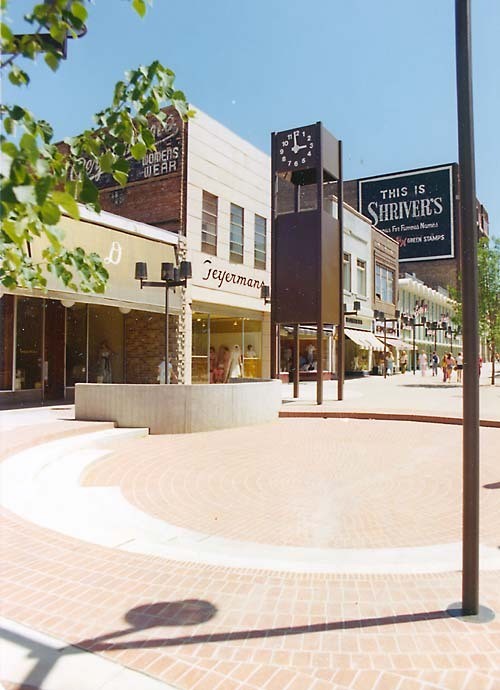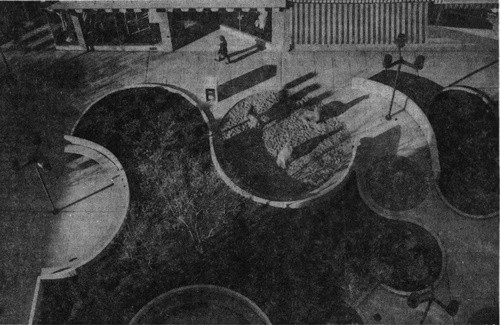Downtown Mall
Phillips Avenue, between 9th Street and 11th Street
In the early 1970s, as downtown was losing its businesses to malls and other more suburban areas, plans were put in place to revive the downtown shopping experience.
By the mid-1960s, the downtown business district was starting to lose life and tenants. It was the center of the city since Sioux Falls was founded. Doctors, dentists, hair salons, department stores, restaurants, theaters, laundries, hotels and more were in a tightly-packed area in the center of the city where they were easily accessed. A resident could work downtown and pop by the bakery on the way home with a fresh loaf of bread.
Over the years, this model changed as the residential areas of Sioux Falls spread out. People wanted the good life in the newer developments with the tree-lined roads. The businesses followed their customers out of the downtown area and set up shop in the malls and in stand-alone buildings nearer to their clients. Downtown buildings began to lose tenants and the owners could not keep up with repairs as their revenues declined. This served to make their buildings less attractive to potential renters.
To save downtown from this urban blight the city needed to do something to compete with the malls. Urban Renewal was part of the plan, tearing down old buildings to encourage new buildings to be erected in their place. Another plan was to make the river area in the downtown area more attractive to citizens; a plan that has only recently come to fruition. The third piece was to close off three blocks on Phillips Avenue between 9th and 12th streets so that shoppers could lazily stroll from store to store in Phillips Avenue’s most popular shopping area. The block between 11th and 12th was removed from the plan by the city commission to make the plan more affordable.
Over the years, this model changed as the residential areas of Sioux Falls spread out. People wanted the good life in the newer developments with the tree-lined roads. The businesses followed their customers out of the downtown area and set up shop in the malls and in stand-alone buildings nearer to their clients. Downtown buildings began to lose tenants and the owners could not keep up with repairs as their revenues declined. This served to make their buildings less attractive to potential renters.
To save downtown from this urban blight the city needed to do something to compete with the malls. Urban Renewal was part of the plan, tearing down old buildings to encourage new buildings to be erected in their place. Another plan was to make the river area in the downtown area more attractive to citizens; a plan that has only recently come to fruition. The third piece was to close off three blocks on Phillips Avenue between 9th and 12th streets so that shoppers could lazily stroll from store to store in Phillips Avenue’s most popular shopping area. The block between 11th and 12th was removed from the plan by the city commission to make the plan more affordable.


The Spitznagel Partners won the bid to design the area, which involved a motif of circles and semi-circles. There were planters, play areas, sand pits, and fountains within these circles. Trees were in abundance to give a more natural feel to the project and to provide shade during the pedestrian mall’s busiest time of the year.
People would walk a half a block to get to the climate-controlled shelter of the malls, but were less likely to find parking downtown to walk to an open air mall that contained fewer stores. The bold plan failed and even now people view it as something that hastened the demise of downtown.
By the mid 1980s most of the city agreed that the pedestrian mall was not going to get any better. Plans were made to remove the walkway and restore traffic to Phillips avenue. The block between 10th and 11th was restored to moving traffic by 1986. The block between 9th and 10th would last two more years until 1988.
Though the pedestrian mall did not save downtown Sioux Falls, at this point it’s impossible to know if it sped up its demise. Downtown’s current resurgence is to be enjoyed, while suggestions of a pedestrian mall will no doubt be quickly subdued.
People would walk a half a block to get to the climate-controlled shelter of the malls, but were less likely to find parking downtown to walk to an open air mall that contained fewer stores. The bold plan failed and even now people view it as something that hastened the demise of downtown.
By the mid 1980s most of the city agreed that the pedestrian mall was not going to get any better. Plans were made to remove the walkway and restore traffic to Phillips avenue. The block between 10th and 11th was restored to moving traffic by 1986. The block between 9th and 10th would last two more years until 1988.
Though the pedestrian mall did not save downtown Sioux Falls, at this point it’s impossible to know if it sped up its demise. Downtown’s current resurgence is to be enjoyed, while suggestions of a pedestrian mall will no doubt be quickly subdued.
©www.GreetingsFromSiouxFalls.com
